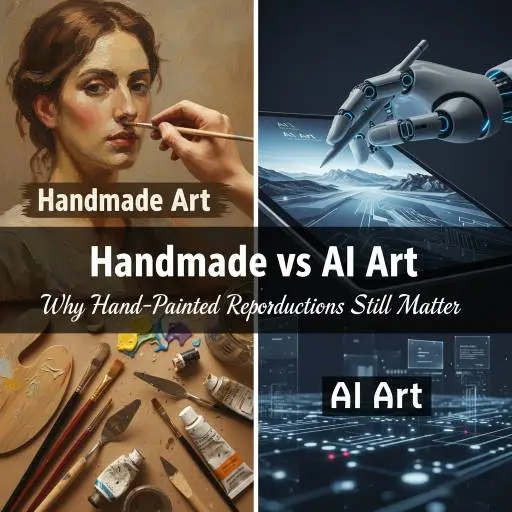Your favourites are only temporarily saved. To find them back, create your account on GFM Painting!
Already have account ?
No gift cards in your cart.
October 06, 2025

 (1).webp)
 (1).webp)
The art world is in the midst of a revolution. With artificial intelligence generating images in seconds, collectors and art lovers are asking: can technology replace the human touch? In this in-depth guide, we explore how handmade art reproductions stand apart from AI creations — and why discerning buyers in the UK and USA continue to choose hand-painted portraits for their emotional value, authenticity, and craftsmanship.
Two global trends have collided: the explosion of AI-generated imagery and the enduring demand for handmade art. The art reproduction market, valued in the billions, continues to grow as homeowners, collectors, and designers seek high-quality recreations of classic masterpieces and personal portraits. Meanwhile, generative AI tools have made it possible to produce realistic images at lightning speed — changing the landscape for both artists and buyers.

Governments and creative sectors across the UK and USA are now debating how AI art fits into copyright law, training data, and fair compensation for original creators. Understanding this landscape helps buyers make informed, ethical choices when investing in artwork. As artificial intelligence continues to evolve, collectors are also questioning what defines originality, authorship, and value in a digital age. Artists, galleries, and policymakers are working to balance innovation with integrity, ensuring that human creativity remains protected while embracing technological progress. This ongoing conversation will shape the future of art ownership and authenticity worldwide, influencing how societies perceive creativity, cultural heritage, and the role of human emotion in the artistic process. With new legislation being proposed and ethical frameworks emerging, both creators and consumers are encouraged to stay informed.
The intersection of technology and art is not only redefining aesthetics but also challenging traditional ideas of labour, credit, and artistic identity. In this rapidly shifting environment, transparency, respect for source material, and a shared commitment to fairness will be essential. Whether commissioning a hand-painted portrait or exploring AI-generated works, every choice contributes to the broader dialogue about the future of creative expression.
A hand-painted reproduction is created by a skilled artist using traditional media such as oil or acrylic paint on canvas. These works recreate a reference — whether a famous painting, a photograph, or a personal image — through genuine craftsmanship. Each brushstroke, layer, and highlight is applied by hand, resulting in texture, depth, and light that digital art cannot replicate.
Buyers commission handmade reproductions for many reasons:
Unlike prints or AI-generated files, no two hand-painted reproductions are identical. Each work carries the character and interpretation of the artist who painted it.
AI art refers to images created or enhanced by artificial intelligence models. Using machine learning and large datasets, these tools can generate visuals from text prompts or transform photographs into styles that mimic famous painters. AI can assist in concepting, style transfer, and upscaling — making it fast, affordable, and scalable.
However, while AI can imitate technique, it cannot replicate the conscious emotion, patience, and subtle imperfections that define human artistry. This distinction becomes important when choosing between digital speed and human touch.

Artificial intelligence is transforming the art world by generating paintings, portraits, and digital masterpieces in seconds. AI art blends algorithms, data, and human creativity to produce images that challenge traditional ideas of authorship and originality. While some celebrate its innovation and accessibility, others question whether machine-made art can truly capture human emotion or intention. The growing debate extends to copyright, ethics, and the ownership of AI-generated works, especially when training data includes human-made pieces. As technology continues to advance, artists and collectors alike are rethinking what defines art in the modern era. Ultimately, AI art invites us to reflect on creativity itself—whether it is born from code, emotion, or the collaboration between humans and machines.
AI art is rapidly reshaping creative industries, allowing machines to produce visually striking works in moments. While it offers efficiency and new styles, it raises questions about originality, authorship, and fair compensation for human artists. Collectors and creators must navigate ethical considerations, ensuring that innovation does not undermine traditional craftsmanship or the value of human creativity in the evolving art landscape.
Research consistently shows that viewers value human-created art more deeply when they know a person made it. The knowledge of effort, creativity, and emotion behind a handmade piece increases its perceived worth. AI art may be visually striking, but it often lacks the authenticity and narrative connection that collectors crave.
When you stand before a hand-painted oil portrait, you can feel the presence of the artist — the way brushstrokes build texture, how colour interacts with light, and how intent translates into form. That human connection is irreplaceable.
AI art raises significant ethical and legal questions. Many AI systems are trained using copyrighted works without explicit permission from artists. As governments in the UK and USA discuss new copyright frameworks, buyers must be aware of how their purchases impact creative rights.
To make ethical art purchases, buyers should:
The global art reproduction market continues to expand, driven by growing interest in bespoke, handmade décor and custom portraits. North America and Europe remain strong markets for hand-painted reproductions, with digital tools serving as complementary aids rather than replacements. Collectors increasingly prioritise authenticity, provenance, and originality — all of which favour handmade works over AI-generated images.
SEO data reveals that buyers are actively searching for:
These high-intent search terms show that handmade art remains a top interest, especially for people seeking personal, long-lasting works rather than mass-produced prints.
At GFM Painting, each artwork is meticulously hand-painted by a professional artist using premium oil paints on linen or cotton canvas. Our process combines classical technique with modern communication, ensuring that every client remains part of the creative journey — from sketch to final varnish.
We do not rely on AI-generated shortcuts. Every portrait and reproduction is painted by hand, preserving the authenticity and integrity that collectors expect. Our transparency, craftsmanship, and passion are what set us apart in a market saturated with digital alternatives.
To ensure quality and authenticity, ask your seller these five key questions:
Hand-painted reproductions cost more than AI-generated prints because they require real human labour, skill, and time. A professional artist may spend dozens of hours perfecting texture, colour, and proportion. This level of craftsmanship gives the work its warmth, presence, and longevity — making it a true investment, not just decoration.
Proper care ensures your painting remains vibrant for generations:
Rather than replacing artists, AI is becoming a creative tool — useful for concept sketches or colour planning, but not the final masterpiece. The future lies in collaboration: human creativity enhanced, not overshadowed, by technology. Buyers who understand this balance can appreciate both innovation and tradition while supporting artists who bring genuine craft to life.
If you value authenticity, emotion, and human touch, a hand-painted reproduction from GFMPainting is the timeless choice. Each piece is more than an image — it’s a story, a legacy, and a tangible expression of artistry that no algorithm can replace.
Visit gfmpainting.com to explore our gallery, view client testimonials, and request your custom commission. Whether you desire a museum-quality reproduction or a personalised portrait from your photo, our artists bring your vision to life — brushstroke by brushstroke.
Handmade oil painting reproductions offer texture, depth, and emotional authenticity that AI art cannot replicate.
AI-generated art is fast, scalable, and cost-effective but lacks the subtle imperfections and human touch of traditional painting.
Collectors in the UK and USA increasingly value hand-painted works for their originality, provenance, and long-term investment potential.
Ethical considerations are crucial, as many AI tools use copyrighted works without permission, while handmade art supports genuine artists.
Choosing between AI and handmade art depends on purpose: décor and experimentation versus heirloom-quality, emotionally resonant pieces.
GFMPainting provides bespoke, hand-painted reproductions, combining classical technique with modern collaboration for timeless, authentic art.
Frequently Asked Questions
A hand-painted reproduction is a painting created by an artist using traditional media like oil or acrylic to recreate a reference image, such as a famous artwork or personal photograph.
AI art is digitally created using algorithms and large datasets, producing images quickly, whereas handmade paintings rely on human skill, brushwork, and emotional interpretation.
Handmade artworks carry authenticity, unique brushstrokes, and emotional depth that AI cannot replicate, making them more meaningful and collectible.
Yes, GFMPainting offers bespoke hand-painted portraits from your photos, capturing lifelike details and personal expression.
Depending on size and complexity, a professional hand-painted reproduction can take several days to weeks to complete.
Yes. They hold long-term value due to craftsmanship, uniqueness, and emotional connection, unlike mass-produced or AI-generated images.
AI art raises ethical concerns, especially if trained on copyrighted works without permission. Buying hand-painted art supports genuine human artists and fair compensation.
Professional artists use high-quality oil or acrylic paints on linen or cotton canvas, ensuring durability and vibrant color that lasts generations.
Keep it away from direct sunlight, dust gently, avoid cleaning fluids, and frame with UV-protective glass for long-lasting preservation.
AI can help in conceptual sketches or color planning, but GFMPainting ensures the final artwork is fully hand-painted, maintaining authenticity and craftsmanship.



GFM Designer Ltd
Maultway Court
67-69 Ruxley Lane
Epsom, Surrey
KT19 0JG. UK
E-MAIL : info@gfmpainting.co.uk
PHONE : +44 (0) 203 592 3482
MOBILE : +44(0) 7834 393 396








